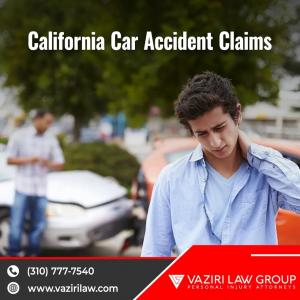Vaziri Law Group Warns: Thousands of Crash Victims May Miss Out on Disability Benefits After Car Accidents
Vaziri Law Group explains how car accident victims with long-term injuries may qualify for disability benefits, and why legal help makes the difference.
For many crash victims, disability benefits are not just financial aid—they are a lifeline that helps them maintain dignity and stability during recovery.”
LOS ANGELES, CA, UNITED STATES, August 22, 2025 /EINPresswire.com/ -- Californians injured in car crashes often discover that the most difficult part of recovery begins after the tow trucks leave and the first round of medical bills arrives. For drivers and passengers who can’t return to work because of lasting injuries, disability benefits may be a vital source of stability. To address ongoing public confusion about who qualifies, how claims are evaluated, and why so many applications are denied at the outset, Vaziri Law Group, APC is releasing a plain-language explainer intended to help injury survivors understand where disability benefits fit into a post-accident recovery plan and how to approach the process with accurate information.— Siamak Vaziri, Managing Partner
The firm’s outreach is prompted by a pattern its attorneys see every month: people with serious crash-related injuries wait to apply because they assume their conditions are temporary, or they file quickly with minimal documentation and are denied, only to learn later that the path to approval requires a more comprehensive record of limitations. The new guidance emphasizes fundamentals that are easy to overlook when someone is coping with pain, medical appointments, lost wages, and family responsibilities. It clarifies that disability programs are not one-size-fits-all, that each has its own eligibility rules, and that the strength of the evidence submitted is just as important as the diagnosis itself.
At the most basic level, disability benefits exist to replace income when a health condition is so significant that it prevents sustained, gainful work. After a collision, that condition might be orthopedic—such as a spinal injury, complex fractures, or post-surgical restrictions—or neurological, such as a traumatic brain injury with lingering cognitive effects. Some people experience a combination of physical and cognitive limitations that together make full-time work impracticable. The firm’s explainer underscores that federal programs like Social Security Disability Insurance (SSDI) and Supplemental Security Income (SSI) apply the same legal standard to everyone, regardless of how the injury occurred, but the evidence required to meet that standard must connect the dots between the crash, the diagnosed impairments, and the day-to-day functional limits that prevent employment.
Because Californians often hear the term “disability” used in several contexts, the announcement distinguishes the different benefit sources accident survivors most commonly encounter. SSDI is a federal program tied to a person’s work history and payroll contributions; SSI is a separate federal program for people with limited income and resources who meet the disability definition even if they do not have sufficient work credits. Many workers also encounter private short-term or long-term disability through an employer benefits plan or a policy they purchased on their own, and Californians may be eligible for state short-term wage replacement under programs that are distinct from federal disability. Each channel has different filing requirements, different proof standards, and different rules about how medical information should be supplied. The message from the firm is not to assume that one application automatically triggers another or that a denial in one program is predictive of an outcome elsewhere.
A hallmark of disability adjudication is its reliance on detailed medical evidence over time. For crash victims, that often means more than operative reports or emergency room records. Decision-makers want to see consistent clinical notes that document functional limitations in ordinary terms: how long a person can sit or stand, whether lifting and carrying provoke symptoms, whether headaches or dizziness interfere with concentration, whether pain or medication side effects restrict safe driving or basic household tasks. A common reason for early denial is a mismatch between how someone describes their daily struggles in an application and what is reflected in the medical chart. The firm’s guidance encourages patients to communicate candidly with treating clinicians about limits, even when those limits seem mundane, because “normal” activities such as reaching overhead, climbing stairs, or focusing on a computer screen can be decisive in an evaluation.
Another practical obstacle is timing. Many people try to push through their injuries, hoping to return to work, and postpone applying. Others file immediately without a complete record. Either approach can create problems. Waiting too long may mean losing months of potential benefits. Filing too early with sparse documentation can lead to a first-round denial that adds delay. The firm’s explainer suggests a middle path: seek prompt medical assessment, follow through with recommended care, and consider the disability application once a treating provider has had a reasonable opportunity to document the condition and its functional impact. The goal is not to game the system, but to present a clear, accurate picture of the reality an injured person faces after the acute phase has passed.
The announcement also addresses the misconception that disability programs only apply to people with permanent paralysis or catastrophic injuries. Many qualifying conditions are less visible but no less disabling in practice. Chronic post-surgical pain, post-concussive symptoms, neuropathy, recurring severe headaches, or a combination of spine and soft-tissue injuries can prevent sustained employment even when a person looks outwardly “fine.” Employers may try to accommodate restrictions, but if the available work still exceeds what a person can safely do on a regular and continuing basis, disability benefits may be appropriate. The firm emphasizes that a credible longitudinal record—built through primary care, specialists, therapy, and diagnostic testing as indicated—is the foundation of a successful claim.
For families, the financial stakes are straightforward. Without income replacement, ordinary expenses like rent, utilities, food, transportation, and child care can become impossible to manage. When recovery requires months of physical therapy or follow-up procedures, the pressure compounds. Disability benefits are not a windfall; they are an income bridge designed to prevent a medical crisis from becoming a financial emergency. Even so, navigating the process can be daunting. Applications require careful descriptions of work history and transferable skills, consistent reporting across forms and medical notes, and, in some cases, testimony at an administrative hearing. The firm’s attorneys note that many denials stem from technical oversights rather than a lack of medical severity, which is why completeness and consistency matter as much as the underlying condition.
The press statement avoids predicting outcomes or offering guarantees. It does, however, set expectations about the kinds of questions the Social Security Administration typically asks: whether a claimant can return to past work, whether there are other jobs in the national economy they could perform with their limitations, and whether the combination of age, education, and skills would realistically allow a transition to work that is lighter or less demanding. These are legal questions informed by medical evidence, not moral judgments about effort or character. As the explainer notes, it is common for conscientious people to downplay symptoms or attempt to “push through” pain. In a disability evaluation, accuracy is not self-pity; it is a requirement.
The announcement further explains that disability benefits may intersect with other elements of an accident recovery. If a person is pursuing a personal injury claim related to the crash, there can be interactions between private disability policies and civil recovery, including provisions about offsets or reimbursement. Federal disability programs have their own rules, including limits on work activity and, in certain programs, resource thresholds. The firm’s guidance does not provide individualized advice in a press release format but encourages the public to be mindful that benefits rarely exist in isolation; choices in one arena may affect another, and asking questions early can help avoid preventable complications.
For Californians, geography and work patterns can complicate the picture. Many residents commute long distances or work in physically demanding sectors where light-duty roles are limited. Others hold multiple part-time positions or gig-economy jobs that were disrupted by injury. Still others are primary caregivers whose unpaid labor at home is essential to family stability. The explainer’s message is inclusive: disability benefits are evaluated on the capacity to perform sustained, gainful activity, not on how deserving or hardworking a person was before the collision. A crash that removes the ability to perform one’s customary work can qualify, even if the individual is motivated and diligent. What matters is whether the combination of medical limitations and realistic job demands leaves room for consistent full-time employment.
The firm’s attorneys also draw attention to medical follow-through as both a health and documentation priority. Missed appointments, gaps in treatment, or inconsistent participation in prescribed therapy can be read as signs of improvement, even when barriers like transportation, child care, or cost are the real issue. For that reason, the guidance encourages patients to tell providers about practical hurdles and to explore options such as community resources, telehealth where appropriate, or scheduling adjustments that keep care on track. The record should reflect the reasons for any interruption so reviewers do not infer recovery where none exists.
Because disability applicants sometimes worry that requesting accommodations at work will undermine their claim, the announcement clarifies that seeking a reasonable adjustment is not inconsistent with applying for benefits. In fact, the documented failure of accommodations to restore sustained work capacity can strengthen the case that a person cannot maintain competitive employment. Conversely, if accommodations are successful and the person returns to work at a level that the law considers substantial, eligibility for disability may be affected. The point, the firm notes, is transparency: the best outcomes result from honest communication with employers, providers, and adjudicators.
The explainer also addresses the role of age and transferable skills. Younger applicants often face higher hurdles because adjudicators expect greater adaptability to new work. Older applicants may benefit from rules that acknowledge the difficulty of retraining into different fields with significant physical or cognitive restrictions. Education and past job complexity similarly influence evaluations. A person with a highly specialized physical job may find it harder to transition after injury than someone whose skills translate readily to sedentary roles. These are legal realities of the disability framework rather than value judgments, and understanding them helps applicants frame their evidence effectively.
Another area of confusion involves pain and credibility. Because pain is subjective, some applicants hesitate to describe its frequency, duration, and intensity. The announcement stresses that specificity helps. Notes that correlate pain reports with clinical findings, observed limitations, or medication regimens are persuasive. Descriptions that explain why pain prevents completion of an eight-hour day, five days per week—rather than merely making tasks unpleasant—address the core of the disability standard. Likewise, documentation of side effects such as drowsiness from necessary medication can be as important as the underlying condition.
Beyond the technicalities, the firm frames its explainer as a public service. Car accidents are disruptive events that reach far beyond the moment of impact. When injuries persist, the consequences touch every corner of a household, from school drop-offs to rent payments to basic daily routines. Disability benefits do not erase those challenges, but they provide predictable support while medical recovery proceeds at the only pace it can: the body’s. Clear information helps families plan. It also reduces the shame and confusion that too often surround the disability process, especially for people accustomed to steady work.
In a brief statement accompanying the release, Managing Partner Siamak Vaziri notes that the goal is clarity, not pressure. He explains that the firm’s attorneys routinely answer questions about disability programs because clients and community members want to know how to keep a roof overhead while they heal. He adds that the systems were designed to ensure continuity of basic needs and that using them as intended is neither opportunistic nor unusual. The firm sees its role as educating the public about the steps that most reliably lead to timely, accurate decisions, even when those decisions are not immediate.
The public education effort also recognizes that not everyone will qualify. Some injuries improve with time and care, and people return to work sooner than expected. Others may be able to work part-time or in modified roles that exceed program limits. The firm is transparent about those possibilities. The explainer recommends that people track their progress, communicate with providers, and reassess periodically. If a person improves enough to work, that is good news; if they don’t, having a well-documented record positions them to pursue benefits without starting from scratch.
The release closes by reminding readers that disability programs are legal frameworks administered by government agencies and private insurers according to rules that change over time. What does not change is the need for accurate, consistent documentation of functional limits and the importance of aligning medical evidence with real-world work demands. For those facing prolonged recovery after a crash, that alignment is the heart of a strong claim.
Members of the public who want to learn more can contact Vaziri Law Group for general information about how disability applications fit within the wider landscape of post-accident recovery. The firm’s outreach is informational and does not create an attorney-client relationship. Individuals should consult the appropriate agencies and, where needed, seek personalized legal guidance regarding their specific circumstances.
About Vaziri Law Group, APC: Vaziri Law Group is a personal injury firm based in Los Angeles that represents individuals harmed by negligence throughout California. The firm’s work includes advocacy for clients navigating the practical aftermath of serious injuries, including access to appropriate medical care and income-replacement programs where eligible. This announcement is part of the firm’s ongoing effort to provide clear, accessible information on topics of public interest affecting injury survivors.
Media Contact: Vaziri Law Group, APC, 1901 Avenue of the Stars, 20th Floor, Los Angeles, CA 90067; Phone: (866) 898-3943; Website: [www.vazirilaw.com](http://www.vazirilaw.com). This communication is intended for general informational purposes only and should not be construed as legal advice. Reading this release does not create an attorney-client relationship. Past results do not guarantee similar outcomes.
Marketing Team
Vaziri Law Group, APC
+1 866-695-5948
email us here
Visit us on social media:
LinkedIn
Instagram
Facebook
YouTube
X
Legal Disclaimer:
EIN Presswire provides this news content "as is" without warranty of any kind. We do not accept any responsibility or liability for the accuracy, content, images, videos, licenses, completeness, legality, or reliability of the information contained in this article. If you have any complaints or copyright issues related to this article, kindly contact the author above.




